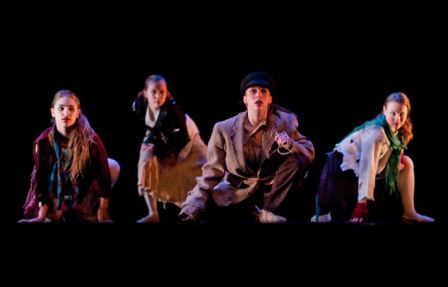Perhaps dance (of the non So You Think You Can Dance variety, anyway) is already too much on the fringe to make much use of a Fringe festival. This year, in any case, the only thing that distinguished the dance offerings I saw at the New York Fringe from what you might get at, say, the downstairs theatre at the Ailey building was that they were worse: either off– like rotten vegetables, not like off-off-Broadway– or amateur, not in the sense of sweetly ebullient but in the sense of bordering on incompetent. At the five shows I took in over two days, I squirmed a lot.
Asylum, by the Nashville troupe Uprock, promised hilarious tastelessness – a perennial Fringe attraction – which its less-than-amateur execution delivered intermittently. Between extended pauses in which the brave dancers engaged in vague shadow play behind upturned hospital cots, the hip-hop ballet offered before and after scenes. The vulnerable characters first appeared on the street, where the damage was done, then in the ward, where they relived their trauma in hallucinations.
In one suitably outrageous number, a young mother whose baby had been catapulted out of her arms by the homeless driver of a shopping cart engaged in a pas de trois with hospital orderlies wearing huge papier-mâché bald-baby heads. In another, a janitor’s coughing fit transmogrified into a hip-hop beat for an asylum boogie.
Also typically Fringe was the monomania behind former Stomp star Yako Miyamoto’s Cobu. Mining the theatrical and choreographic possibilities of women banging on big drums, her seven-member troupe seemed half-witch, half samurai, in their yoking of martial exactitude and demonic energy. They leapt into the air to thwack the cauldron-shaped taiko drums with thick sticks and dashed from drum to drum in myriad geometries.
Unlike the Uprockers, Miyamoto put on a tight show, with colourful costume additions – long vests, samurai pantaloons, sequined midriff wraps – designating separate numbers. But there is a reason taiko favours short sets. An hour and a half of drumming, no matter what the accessory thrills, is too much….
The Covent Ballet Theatre of Brooklyn may have given off a whiff of school recital on opening night, with so many of the performers’ families in the house, but bringing to story ballet the social conscience of modern dance circa the 1920s and ’30s suits the combo-crazy Fringe. A historical fiction of a ballet, Orphan Train was inspired by the thousands of New York urchins sent west from 1853 until 1929 to be adopted by farm families.
Some of the wonderful children of Orphan Train. Photo by Barry Yanowitz courtesy of the NY Fringe.
Choreographer Marla Hirokawa made excellent use of the mix of children and adults in patterns that were simple without ever being dull and that cleanly telegraphed mood. Her libretto, however, gave me pause. Many fairytales risk the hero’s life and many more subject a motherless child to wicked witches and stepmothers, but how many have the good child himself die – only to replace him cheerfully with another child? The little boy in my row who had been peppering his father with questions on murky plot points was dumbstruck by that one.
Still more deserving of a “What were they thinking?” award…
For the mystery clueless dance, click here.


Leave a Reply